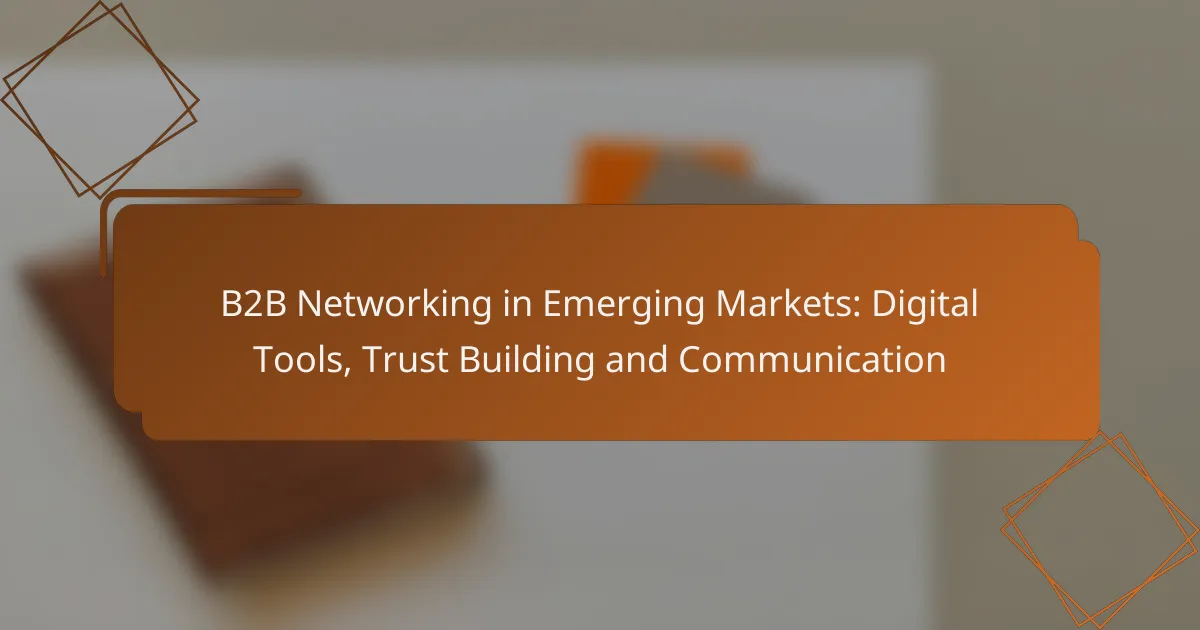B2B networking in emerging markets is increasingly reliant on digital tools that facilitate communication and relationship-building. Establishing trust is essential, and businesses can achieve this by forming local partnerships, showcasing testimonials, and engaging with their communities. By leveraging effective communication strategies, companies can enhance their networking efforts and foster meaningful collaborations.

How to Build Trust in B2B Networking in Emerging Markets?
Building trust in B2B networking within emerging markets requires a strategic approach that emphasizes credibility, transparency, and relationship-building. Key methods include forming local partnerships, showcasing testimonials, utilizing online reviews, and engaging in community initiatives.
Establishing Credibility through Local Partnerships
Forming partnerships with established local businesses can significantly enhance your credibility in emerging markets. These collaborations not only provide access to local knowledge but also signal to potential clients that you are committed to the market.
Consider joint ventures or strategic alliances that align with your business goals. This approach can help mitigate risks and build trust more quickly, as local partners can vouch for your reliability and expertise.
Leveraging Testimonials and Case Studies
Testimonials and case studies from satisfied clients are powerful tools for building trust. They provide tangible evidence of your capabilities and successes in similar markets or industries.
When showcasing testimonials, focus on those that highlight specific outcomes, such as increased efficiency or cost savings. Case studies should detail the challenges faced, the solutions provided, and the results achieved, ideally in a format that is easy to digest.
Utilizing Social Proof via Online Reviews
Online reviews play a crucial role in establishing trust, especially in emerging markets where potential clients often rely on peer feedback. Encourage satisfied customers to leave positive reviews on platforms relevant to your industry.
Monitor your online reputation actively and respond to reviews, both positive and negative. This engagement shows that you value customer feedback and are committed to continuous improvement.
Engaging in Community Initiatives
Participating in community initiatives can enhance your reputation and build trust within local markets. This involvement demonstrates your commitment to the community and can foster goodwill among potential clients.
Consider sponsoring local events, supporting educational programs, or collaborating with non-profits. These actions not only improve your visibility but also create opportunities for networking and relationship-building with local stakeholders.

What Digital Tools Facilitate B2B Networking?
Digital tools play a crucial role in enhancing B2B networking by enabling seamless communication, fostering relationships, and facilitating collaboration. These tools help businesses in emerging markets connect with potential partners, clients, and stakeholders efficiently.
LinkedIn for Professional Connections
LinkedIn is a powerful platform for establishing professional connections and expanding networks. Users can create profiles that showcase their skills, experience, and business offerings, making it easier to find and connect with relevant contacts.
To maximize LinkedIn’s potential, engage with content, join industry-specific groups, and send personalized connection requests. Avoid generic messages; instead, mention mutual interests or connections to increase acceptance rates.
Zoom for Virtual Meetings
Zoom is widely used for virtual meetings, allowing businesses to conduct face-to-face discussions regardless of geographical barriers. Its features, such as screen sharing and breakout rooms, enhance collaboration during meetings.
When using Zoom, ensure a stable internet connection and familiarize yourself with the platform’s functionalities. Schedule meetings in advance and send calendar invites to participants, keeping time zone differences in mind.
Slack for Team Collaboration
Slack serves as a hub for team collaboration, enabling real-time communication through channels, direct messaging, and file sharing. This tool helps streamline discussions and keeps all team members informed about ongoing projects.
To effectively use Slack, create channels based on specific projects or topics and encourage team members to share updates regularly. Be mindful of notification settings to avoid information overload while ensuring important messages are not missed.
CRM Systems like HubSpot for Relationship Management
CRM systems such as HubSpot are essential for managing customer relationships and tracking interactions. These platforms help businesses organize contact information, monitor sales pipelines, and analyze customer data to enhance engagement strategies.
When implementing a CRM, ensure that all team members are trained to use it effectively. Regularly update the database with new information and utilize analytics features to identify trends and areas for improvement in your networking efforts.

What Communication Strategies Enhance Networking?
Effective communication strategies are crucial for enhancing networking in B2B contexts, especially in emerging markets. Tailoring your approach to build trust and foster relationships can significantly improve engagement and collaboration.
Personalized Messaging Techniques
Personalized messaging techniques involve customizing your communication to address the specific needs and interests of your contacts. This can include using their name, referencing previous conversations, or acknowledging their business achievements. Such tailored messages can increase response rates and foster a sense of connection.
Consider segmenting your audience based on industry or interests to create more relevant content. For example, if you’re reaching out to a tech startup, highlight innovations or trends in their sector that align with their goals.
Regular Follow-ups and Check-ins
Regular follow-ups and check-ins are essential for maintaining relationships and demonstrating your commitment. Scheduling periodic updates or casual check-ins can keep the lines of communication open and show that you value the partnership. Aim for follow-ups every few weeks or monthly, depending on the relationship’s depth.
Be mindful of cultural differences in communication frequency; some regions may prefer more or less frequent contact. For instance, in Eastern Europe, a monthly check-in might be appropriate, while in other regions, bi-weekly may be more effective.
Utilizing Video Content for Engagement
Utilizing video content can significantly enhance engagement by providing a more personal touch. Videos can convey complex information more effectively than text and allow for a more dynamic interaction. Consider using video messages for introductions, product demonstrations, or sharing insights.
Keep videos concise, ideally under two minutes, to maintain viewer interest. Incorporating local language or cultural references can also make your content more relatable and impactful in emerging markets.

What Are the Key Challenges in Emerging Markets?
Emerging markets present unique challenges for B2B networking, primarily due to cultural differences, limited technology access, and the need to build trust in competitive environments. Understanding these obstacles is crucial for effective communication and relationship-building in these regions.
Cultural Differences in Communication Styles
Cultural differences significantly influence communication styles in emerging markets. For instance, some cultures may prioritize indirect communication, valuing context and relationships over straightforwardness. This can lead to misunderstandings if not approached with sensitivity.
To navigate these differences, it’s essential to research local customs and adapt your communication style accordingly. Engaging in active listening and showing respect for local practices can foster better connections.
Limited Access to Technology
Many businesses in emerging markets face limited access to advanced technology, which can hinder effective networking. Internet connectivity may be inconsistent, and reliance on mobile devices can vary widely. This creates challenges in using digital tools for communication and collaboration.
To overcome these limitations, consider using low-bandwidth communication tools and offline resources. Establishing a presence in local networks can also help bridge the technology gap, allowing for more effective engagement.
Building Relationships in Competitive Environments
In competitive markets, building relationships is essential yet challenging. Trust is often established through personal interactions rather than digital communication, making face-to-face meetings crucial. However, the competitive landscape can make it difficult to secure time with potential partners.
To effectively build relationships, prioritize networking events and local business gatherings. Follow up consistently and demonstrate genuine interest in your contacts’ needs and goals. This approach can help differentiate your business and foster long-term partnerships.

How to Choose the Right Networking Tools?
Choosing the right networking tools involves evaluating their usability, integration capabilities, and overall value. Focus on tools that enhance communication and relationship-building in your specific market context.
Assessing User-Friendliness and Accessibility
User-friendliness is crucial for effective networking. Look for tools that have intuitive interfaces and provide easy navigation, ensuring that all team members can utilize them without extensive training.
Accessibility is equally important, especially in emerging markets where internet connectivity may vary. Opt for tools that offer mobile access and work efficiently on lower bandwidths to accommodate diverse user environments.
Evaluating Integration with Existing Systems
When selecting networking tools, consider how well they integrate with your current systems, such as CRM or project management software. Seamless integration can streamline workflows and enhance data sharing.
Check if the tools support APIs or have built-in connectors for popular platforms. This can save time and reduce the need for manual data entry, leading to improved efficiency in your networking efforts.
Considering Cost vs. Value Proposition
Cost is a significant factor when choosing networking tools, especially for businesses in emerging markets with tighter budgets. Compare subscription fees against the features offered to ensure you are getting good value.
Look for tools that provide a free trial or tiered pricing options, allowing you to assess their effectiveness before committing financially. Consider the long-term benefits, such as improved lead generation and relationship management, which can justify higher initial costs.
